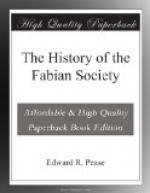Meanwhile the withdrawal of some of the older had by no means satisfied the younger generation, and during the autumn of 1911 a Fabian Reform Committee was constituted, with Henry H. Slesser as Chairman, Dr. Marion Phillips as Vice-Chairman, Clifford Allen as Secretary, and fifteen other members, including Dr. Ethel Bentham, who, like Mr. Slesser, was a member of the Executive. Their programme, like that of Mr. Wells, included a number of reforms of procedure, none of them of much consequence; and a political policy, which was to insist “that if Fabians do take part in politics, they should do so only as supporters of the Labour Party."[41] The campaign of the Committee lasted a year, and as usual in such cases led to a good deal of somewhat heated controversy over matters which now appear to be very trivial. It is therefore not worth while to recount the details of the proceedings, which can be found by any enquirer in the pages of “Fabian News.” Two of the leaders, Dr. Marion Phillips and Clifford Allen, were elected to the Executive at the election of 1912, and some of the administrative reforms proposed by the Committee were carried into effect. The Reformers elected to fight the battle of political policy on point of detail, until in July, 1912, the Executive Committee resolved to bring the matter to an issue, and to that end moved at a members’ meeting: “That this meeting endorses the constitutional practice of the Society which accords complete toleration to its members; and whilst reaffirming its loyalty to the Labour Party, to which party alone it as a society has given support, it declines to interfere ... with the right of each member to decide on the manner in which he can best work for Socialism in accordance with his individual opportunities and circumstances.” (The phrase omitted refers to the rule about expulsion of members, a safeguard which in fact has never been resorted to.) An amendment of the Reformers embodying their policy was defeated by 122 to 27 and after the holiday season the Reform Committed announced that their mission was accomplished and their organisation had been disbanded[42].
“Fabian Reform” embodied no new principle all through the history of the Society there had been a conflict between the “constitutional practice” of political toleration, and the desire of a militant minority to set up a standard of party orthodoxy, and to penalise or expel the dissenters from it.
The next storm which disturbed Fabian equanimity involved an altogether new principle, and was therefore a refreshing change to the veterans, who were growing weary of winning battles fought over the same ground. In order to explain this movement it is necessary to describe a new development in the work of the Society.




